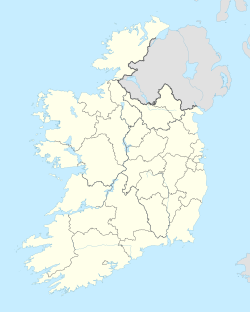Killeshin Church
Glenn Uisin | |
 | |
| Monastery information | |
|---|---|
| Other names | Killushin, Glenn Ussen, Glenn Uissen, Glenn Uisen |
| Order | Celtic Christianity |
| Established | AD 545 |
| Diocese | Leighlin |
| People | |
| Founder(s) | Saint Diarmait mac Siabairr |
| Important associated figures | Saint Comgán |
| Architecture | |
| Status | Inactive |
| Heritage designation | National Monument |
| Style | Irish monastic, Romanesque |
| Site | |
| Location | Killeshin, County Laois |
| Coordinates | 52°50′51″N 7°00′05″W / 52.84738°N 7.00151°W |
| Visible remains | Part of church (west and east gables; part of north elevation) |
| Public access | yes |
| Official name | Killeshin |
| Reference no. | 115[1] |
Killeshin Church is a 12th-century Romanesque church and National Monument located in County Laois, Ireland.
Location
[edit]Killeshin Church is located near Killeshin village, on the south bank of the Fushoge River (a tributary of the Barrow), about 5 km (3 mi) west of Carlow town. A ringfort, known as Killeshin moat, stands to the southeast.
History
[edit]A monastery was founded on the site c. AD 545 by Diarmait mac Siabairr, a member of the local Uí Bairrche ruling family.[2]
The monastery was plundered by Diarmait mac Máel na mBó in 1041; the dairthech (oak prayer house) was demolished, a hundred people taken away as slaves and 700 cattle also seized. This attack was a retaliation against the burning of Ferns by Murchadh mac Dunlaing and the murder of Domnall Remar (Donal the Fat, Diarmait's brother).[3] Killeshin was burned again in 1077, along with its yew trees.
None of this original monastery survives; a round tower once stood there but was torn down by the landowner in 1704.[4]
The buildings
[edit]The church, built in the 12th century AD (probably in 1150–60),[5] is built of rubble masonry with dressed quoins and is particularly noted for its Romanesque archway, zoomorphic carvings and Scandinavian-influenced knotwork. There is also a granite font.
An inscription near the door reads ORAIT DO DIARMAIT RI LAGEN, Middle Irish for "a prayer for Diarmait, king of Leinster", referring to Diarmait Mac Murchada (r. 1126–71).[6]
References
[edit]- ^ "National Monuments of County Laois in State Care" (PDF). heritageireland.ie. National Monument Service. p. 1. Retrieved 2 July 2020.
- ^ ""The Founding of Killeshin"". sites.rootsweb.com. Archived from the original on 21 September 2020. Retrieved 6 February 2019.
- ^ "Uí Bairrche (Leinster) - Page 2". Archived from the original on 12 March 2016. Retrieved 22 November 2015.
- ^ "The Romanesque church at Killeshin, Co. Laois, near Carlow". www.culturalheritageireland.ie.
- ^ Colm (2 November 2014). "The wonderful 12th century R omanesque doorway at Killeshin, Laois - Irish Archaeology".
- ^ Meehan, Cary (2004). Sacred Ireland. Somerset: Gothic Image Publications. p. 398. ISBN 0 906362 43 1.


 French
French Deutsch
Deutsch